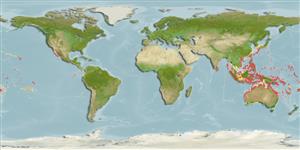>
Gobiiformes (Gobies) >
Gobiidae (Gobies) > Gobiinae
Etymology: Valenciennea: From Achille Valenciennes 1794-1865; he worked with Duméril, Cuvier and Lacepède since 1815; malacologist, author of a "Histoire naturelle des poissons" (Ref. 45335).
More on authors: Lay & Bennett.
Environment: milieu / climate zone / depth range / distribution range
ນິເວດວິທະຍາ
ສັດທະເລ ກ່ຽວກັນຫີນ; ລະດັບຄວາມເລິກ 2 - 30 m (Ref. 27115), usually ? - 6 m (Ref. 8527). Tropical; 22°C - 27°C (Ref. 27115)
Indo-West Pacific.
ຂະໜາດ / ນ້ຳໜັກ / Age
Maturity: Lm ? range ? - ? cm
Max length : 18.0 cm SL ຕົວຜູ້/ບໍ່ມີເພດ; (Ref. 48637)
ຄີ (ໜາມ)ແຂງຢູ່ຫຼັງປາ (ທັງໝົດ): 6 - 7; ຄີຫຼັງຂອງປາ (ຄີອ່ອນ) (ທັງໝົດ): 12-13; ຄີ(ໜາມ) ແຂງຢູ່ຄີກົ້ນປາ
ກຸ່ມປາກະດູກແຂງ
ຄວາມຖີ່ຂອງກຸ່ມຖ່າຍທອດພັນ
ປາທີ່ມີການເຄື່ອນຍ້າຍຈາກທະເລໄປຫານ້ຳຈືດ ແລະນ້ຳຈືດຫາທະເລ
ປາທີ່ມີການເຄື່ອນຍ້າຍຈາກທະເລແລະໄປໄຂ່ຢູ່ນ້ຳຈືດ
ຄີກົ້ນຂອງປາ
ສັດທີ່ມີກະດູກສັນຫັຼງ
ການຖ່າຍທອດທາງກຳມະພັນຈາກພໍ່ແມ່ຫາລູກ 1; ຄີກົ້ນຂອງປາ: 11 - 13. Characterized by pale grey body color, grading to white ventrally; presence of five, blue-edged bars extending ventrally to middle of side, each bar containing reddish brown to black blotch at bottom; blue bands; spots on head; pectoral fin base with a pair of pink stripes; dorsal fin with narrow pink bands and blue to reddish spots on second dorsal and caudal fins; without dorsal filamentous spines; rhomboid caudal fin, longer than head; length of caudal fin 2.7 in SL; longitudinal scale series 80-121; ctenoid body scales , becoming cycloid anteriorly below first or second dorsal spine; head or midline of nape without scales; side of nape with scales extending forward to above middle of operculum; usually scaled pectoral fin base in adult; partly or fully scaled prepelvic area of adult; depth of body 6.0-6.7 in SL (Ref. 90102).
Occurs in areas of fine sand and shallow lagoon reefs at depths less than 3 m, rarely at depths greater than 6 m. Adults usually in pairs, constructing burrows under rubble. Monogamous (Ref. 52884, 48637). Feeds on small invertebrates (e.g. copepods, amphipods, ostracods, nematodes, and foraminiferans) by sifting mouthfuls of sand.
Life cycle and mating behavior
ການຈະເລີນເຕັມໄວ | ການສືບພັນ | ການວາງໄຂ່ | ໄຂ່ | ຄວາມດົກຂອງໄຂ່ປາ | ຕົວອ່ອນ
After spawning, a paired female constructs a mound on the burrow made up of dead coral fragments while the male watches over the eggs in the burrow (Ref. 85149). The mound promotes water-exchange in the burrow which helps the male in tending the eggs (Ref. 85149). The amount of female parental investment is displayed by the height of the constructed mound (Ref. 85149). Consequently, larger females build higher mounds which affects male mating preference (Ref. 85149). Monogamous mating is observed as both obligate and social (Ref. 52884).
Hoese, D.F. and H.K. Larson, 1994. Revision of the Indo-Pacific gobiid fish genus Valenciennea, with descriptions of seven new species. Indo-Pac. Fish. (23):71 p. (Ref. 8527)
IUCN Red List Status (Ref. 130435)
Threat to humans
Harmless
Human uses
ການປະມົງ: ທີ່ເປັນການຄ້າໜ້ອຍ; ຕູ້ປາ: ເປັນສີນຄ້າ
ຂໍ້ມູນຕື່ມອີກ
ຊື່ສາມັນຄຳສັບຄ້າຍຄືກັນການເຜົາໃໝ້ພະລັງງານໂດຍປ່ຽນທາດອາຫານໃນຮ່າງກາຍໃຫ້ກາຍເປັນຊີ້ນແລະໜັງຜູ້ລ້າການສຶກສາຜົນກະທົບຂອງສານຜິດທີ່ມີຜົນກະທົບຕໍ່ລະບົບນິເວດການສືບພັນການຈະເລີນເຕັມໄວການວາງໄຂ່ການສັງລວມການວາງໄຂ່ຄວາມດົກຂອງໄຂ່ປາໄຂ່Egg development
ເອກະສານອ້າງອີງການລ້ຽງສັດນ້ຳຂໍ້ມູນການລ້ຽງສັດນ້ຳສາຍພັນກຳມະພັນElectrophoresesການຖ່າຍທອດທາງກຳມະພັນຈາກພໍ່ແມ່ຫາລູກພະຍາດການປຸງແຕ່ງNutrientsMass conversion
ເຄື່ອງມື
Special reports
Download XML
ແຫຼ່ງອີນເຕີເນັດ
Estimates based on models
Preferred temperature (Ref.
123201): 24.3 - 29.3, mean 28.5 °C (based on 2431 cells).
Phylogenetic diversity index (Ref.
82804): PD
50 = 0.5000 [Uniqueness, from 0.5 = low to 2.0 = high].
Bayesian length-weight: a=0.00661 (0.00363 - 0.01204), b=3.09 (2.94 - 3.24), in cm total length, based on LWR estimates for this species & (Sub)family-body (Ref.
93245).
ຊັ້ນເຂດຮ້ອນ (Ref.
69278): 3.0 ±0.1 se; based on diet studies.
ຄວາມຢືດຢຸ່ນ (Ref.
120179): ຂະໜາດກາງ, ປະຊາກອນຕຳ່ສຸດທີ່ໃຊ້ເວລາສອງເທົ່າ 1.4 - 4.4 ປີ (Preliminary K or Fecundity.).
Fishing Vulnerability (Ref.
59153): Low vulnerability (12 of 100).
Nutrients (Ref.
124155): Calcium = 90 [40, 161] mg/100g; Iron = 0.623 [0.325, 1.187] mg/100g; Protein = 17.9 [16.0, 19.6] %; Omega3 = 0.082 [0.037, 0.153] g/100g; Selenium = 26.9 [13.7, 56.3] μg/100g; VitaminA = 110 [28, 381] μg/100g; Zinc = 1.74 [1.15, 2.55] mg/100g (wet weight);
